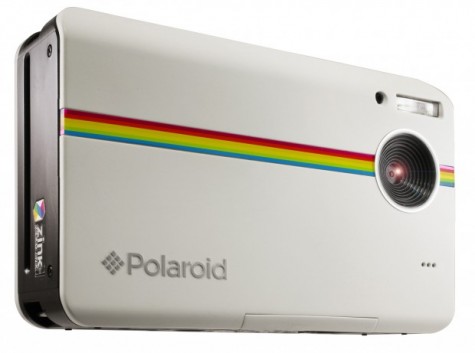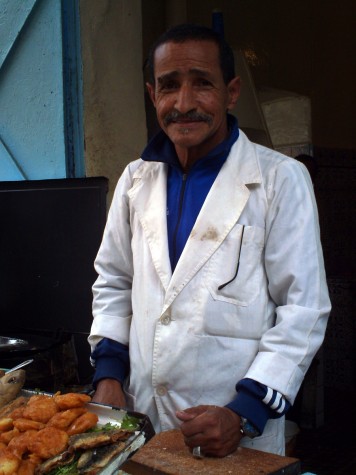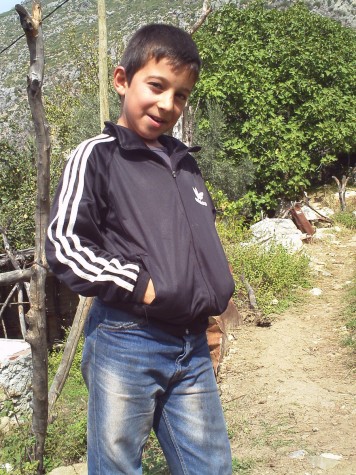It promised to solve a particular travel dilemma.

You know how you take a photo of some nice kids, or a particularly sweet family, and say, “I’ll send you photos!”? You totally mean it at the time, and dutifully copy down their address. And yet, when you get home, somehow the motivation leaves you, and then five years after the fact, you’re still feeling periodic guilt about those nice people in the beehive village in Syria? I mean, for example.
So. I’d considered buying a Polaroid, the old clunky kind—but then you give away your only copy. Really, I wanted a camera where I could give the pic to the person, and keep a copy for myself.
Which is what the Zink Z2300 does! Miraculous! You take a digital photo, then, if you like the pic, you press a couple of buttons, and presto, the camera spits out a teeny-weeny print from a slot in its side.

Well, not spits. More like sloooowly extends its tongue.
Anyway, I’ve road-tested the Z2300 (terrible name, by the way—why the numbers? It’s the very first one!) in Morocco, and I can tell what’s good and bad about it.
The good: it works. People are pretty impressed by it. And something I thought was a drawback—the small size of the photos—was a plus for one photo recipient. “If it were a normal size, I’d be like, enh. But it’s so cute and small!” said my friend Btissam. (Translating freely from Arabic.)
The bad: the quality of the camera is relatively basic. It boasts of 10 megapixels, but the sensor is probably only as big as a bedbug. My digital photos from it aren’t anything I want to print or use for anything substantial.
The display screen is so lo-res that it makes every photo look crappier than it is (though not as bad as I first thought–when I realized it had a protective film on it that could be peeled off).
It’s also pretty boxy, to hold the printing apparatus–though when you consider what it does, it’s impressive it’s as small as it is.
In practice, this meant I was carrying around the chunky Polaroid along with my regular, fancier camera (a Canon G12, also new on this trip). And my iPhone.
On the other (good) hand, the simplicity means it’s easy to hand to someone else and say, “Just press the big red button.” To judge from the packaging, covered in snaps of people doing zany things, it was designed for drunks in mind. This means children can also use it.

In fact, it looks so simplistic that it’s misleading. This is another bad thing. I’m normally an avid manual-reader, but I was lulled into thinking this camera didn’t even call for it. For about two weeks, I thought the only thing I could adjust was flash on or off. Then one day I accidentally pressed a button, and a whole menu of shooting modes (portrait, night shot, etc) came up. Der.
The other not-immediately-logical thing is the macro-lens option: it’s a little slider on the side of the camera. I jostled it once without realizing, and then for two days couldn’t figure out why all my photos were coming out blurry.
But another good: It wasn’t too expensive. If it had cost any more, I’d have serious buyer’s remorse.
But like printers and razors, the pricey part comes from the supplies. I wasn’t using the camera left and right because I didn’t want to run through the paper—I lived in fear of being discovered by a mob of kids, all demanding their own print.

Am I totally sold? Did it revolutionize my travel experience? I was going to say, Not really. But looking over just the handful of photos I took, it was well worth it–normally I don’t have any pictures of people.
I’m not a natural, outgoing, interact-with-people-to-get-the-best-shot photographer. But the Z2300 gave me a little bit of an excuse–even if there was an awkward calculus of when to use the camera, and how clumsy it would be to get it out, explain what was going on, waiting around for the photo to spit out, etc.
Near the end of my trip, I just took a random photo with it, though, rather than a portrait–and I realized I should’ve been doing more of this. It looked nice enough onscreen that I went up to the shop-owner and gave him a photo. He grinned and gave me a huge bag of olives. Aw.

Would I recommend it? Yes. It’s just plain fun, and I like the idea that I’ve left souvenir photos with a whole range of people.
But you shouldn’t buy the white version. Mine is already covered with schmutz. Black is much better for travel.
And, if you don’t have a trip or a wild-n-crazy party coming up, you might want to wait. The next iteration of the Zink Z2300 (will they call it the 2301? Or the 2400? The 4600? Seriously, what? It sounds like a 70s sports car) will almost certainly be smaller and lighter, and have a better screen.
And it will even cost less. Then I’ll have buyer’s remorse.
At least the photo paper will cost the same.